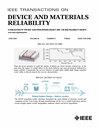Moisture Dependent Degradation Rate of Silicone in LED Optical Housing Material—Ab-Initio Modelling
IF 2.5
3区 工程技术
Q2 ENGINEERING, ELECTRICAL & ELECTRONIC
IEEE Transactions on Device and Materials Reliability
Pub Date : 2022-09-27
DOI:10.1109/TDMR.2022.3209710
引用次数: 1
Abstract
Degradation of LED housings which make up of polydimethylsiloxanes (PDMS) in outdoor applications has been one of the rising concerns as they reduce the overall lifetime of the LED leading to cost and safety issues. The primary stressors for such LED degradation were found to be humidity and light emitted from the LED dice. The degradation mechanisms are hydrolysis and condensation of PDMS which themselves are interdependent. The degradation rate was also found to be dependent on the humidity level. This work identifies these dependencies, using ab-initio density functional theory and molecular dynamics simulation, and the results agree with the reported experimental data. From the detail understanding of the degradation mechanisms and the identification of the rate determining factors which are moisture level and the level of light absorption in PDMS, acceleration models commonly used for extrapolation are questioned, and new quality indexes of the PDMS are also identified to ensure the durability of LEDs in outdoor applications. Testing method to evaluate these new quality indexes is also proposed.LED光学外壳材料中硅酮的水分依赖降解率- ab - initio模型
在户外应用中,由聚二甲基硅氧烷(PDMS)组成的LED外壳的降解一直是人们日益关注的问题之一,因为它们降低了LED的整体使用寿命,导致成本和安全问题。这种LED退化的主要压力源被发现是湿度和LED骰子发出的光。降解机制为PDMS的水解和缩合,两者相互依赖。降解速率还与湿度水平有关。本研究利用从头算密度泛函理论和分子动力学模拟,确定了这些依赖关系,结果与报道的实验数据一致。通过对PDMS降解机理的详细了解,以及PDMS中水分含量和光吸收水平等速率决定因素的确定,对常用的外推加速度模型提出了质疑,并确定了PDMS的新质量指标,以确保led在户外应用中的耐久性。提出了评价这些新质量指标的测试方法。
本文章由计算机程序翻译,如有差异,请以英文原文为准。
求助全文
约1分钟内获得全文
求助全文
来源期刊

IEEE Transactions on Device and Materials Reliability
工程技术-工程:电子与电气
CiteScore
4.80
自引率
5.00%
发文量
71
审稿时长
6-12 weeks
期刊介绍:
The scope of the publication includes, but is not limited to Reliability of: Devices, Materials, Processes, Interfaces, Integrated Microsystems (including MEMS & Sensors), Transistors, Technology (CMOS, BiCMOS, etc.), Integrated Circuits (IC, SSI, MSI, LSI, ULSI, ELSI, etc.), Thin Film Transistor Applications. The measurement and understanding of the reliability of such entities at each phase, from the concept stage through research and development and into manufacturing scale-up, provides the overall database on the reliability of the devices, materials, processes, package and other necessities for the successful introduction of a product to market. This reliability database is the foundation for a quality product, which meets customer expectation. A product so developed has high reliability. High quality will be achieved because product weaknesses will have been found (root cause analysis) and designed out of the final product. This process of ever increasing reliability and quality will result in a superior product. In the end, reliability and quality are not one thing; but in a sense everything, which can be or has to be done to guarantee that the product successfully performs in the field under customer conditions. Our goal is to capture these advances. An additional objective is to focus cross fertilized communication in the state of the art of reliability of electronic materials and devices and provide fundamental understanding of basic phenomena that affect reliability. In addition, the publication is a forum for interdisciplinary studies on reliability. An overall goal is to provide leading edge/state of the art information, which is critically relevant to the creation of reliable products.
 求助内容:
求助内容: 应助结果提醒方式:
应助结果提醒方式:


